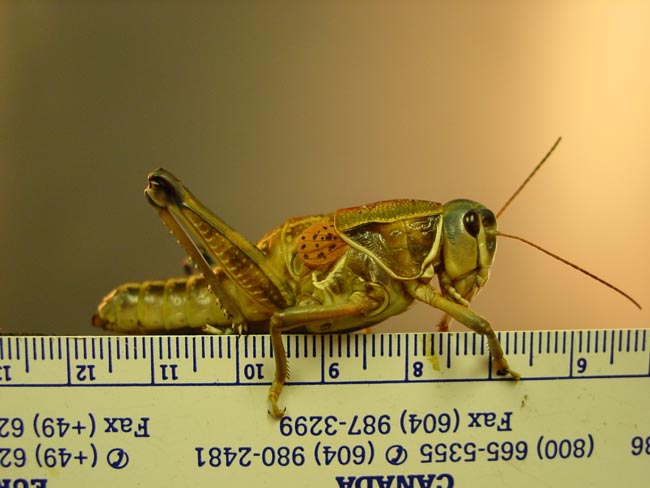How Grasshoppers Are Like Lance Armstrong

WASHINGTON—Equipped with long, lean legs and an athleticism that rivals Lance Armstrong, grasshoppers are designed to jump and fly. One scientist recently put 20 grasshopper species, ranging from teensy to mega-sized, to the jumping test and found they have a remarkable resemblance to hopping humans. The critters rely on sprinting femur muscles for quick jumps that launch them sky-high, and like their human counterparts, they have to overcome drag. “[The grasshopper muscle] is the only invertebrate muscle that functions like our sprinting muscle,” said Scott Kirkton of Union College in New York, who presented his research here at a meeting of the American Physiological Society (APS). However, to top grasshoppers in the long jump, relative to their body length or height, an average adult male human would have to soar a distance of nearly 90 feet. Tiny sprinters Grasshoppers develop in stages called instars, in which the insects molt and grow larger until they are adults. The juveniles can’t fly and instead rely on speedy jumps to escape from predators and to migrate. The grounded youths seem to have a never-ending supply of energy as they can jump and jump and jump. Once adult, the grasshoppers rely on powerful single jumps to launch into the air for flight. These quick bursts of energy are akin to those that fuel human sprinting—the muscles are powered by non-oxygen processes called anaerobic pathways. The result is an explosive release of muscle power and a buildup of lactic acid, the chemical that causes muscle soreness. “So they go from being these little grasshoppers that can jump and jump without fatiguing to becoming older, and every time they molt, they fatigue more as they jump and they produce more lactate,” Kirkton told LiveScience. Jump-athon Is this jumping skill just a result of size, since bigger grasshoppers should have more muscle mass, or some sort of change in how leg muscles operate? To find out, Kirkton measured jumping distances for 20 species of grasshoppers, ranging in weight from about 0.2 grams to 7 grams (less than a quarter of an ounce). He found that on average they all hopped the same distance, nearly 38 inches, no matter the size.
Biomechanics rules suggest all animals, assuming each has the same proportion of jumping muscles relative to body mass, should jump about the same distances. So Kirkton expected all the hoppers to show a similar ratio of muscle to body mass. However, the tinier grasshoppers were beefier than their larger relatives. “It turns out the little ones have more muscle than you’d expect, so they should be doing better,” Kirkton said. In smaller grasshoppers the jumping muscle accounted for 6 percent of the body mass compared with 1 percent in the largest grasshoppers. The small grasshoppers also had longer legs. “If you have a longer limb, you have a longer lever to accelerate,” Kirkton said. The puzzle can be solved by thinking about drag, he said. Even though the smaller grasshoppers were equipped with longer, more muscle-packed legs, Kirkton suggests they have a tougher time contending with oncoming air molecules than bigger-bodied hoppers. Similarly, for instance, an ant would struggle to push through a puddle of water while a puppy would just scamper through. The increased drag puts an increased energy strain on the small grasshoppers’ muscles, causing them to resort to the anaerobic pathway more often and produce more lactate. After the jump-athon, Kirkton dissected the grasshoppers’ legs, measuring the muscle mass and the amount of lactate in the muscles. Smaller grasshoppers had 85 percent more lactate in their jumping muscles compared with larger grasshoppers. Kirkton hopes to someday use grasshoppers as a model to look at some biomedical questions related to muscle performance. “This is the only insect muscle we know of that produces lactate during exercise,” he said.
- Images: Backyard Bugs
- How Many Muscles Does a Human Have?
- Body Quiz 1: The Parts List
Get the world’s most fascinating discoveries delivered straight to your inbox.
Jeanna Bryner is managing editor of Scientific American. Previously she was editor in chief of Live Science and, prior to that, an editor at Scholastic's Science World magazine. Bryner has an English degree from Salisbury University, a master's degree in biogeochemistry and environmental sciences from the University of Maryland and a graduate science journalism degree from New York University. She has worked as a biologist in Florida, where she monitored wetlands and did field surveys for endangered species, including the gorgeous Florida Scrub Jay. She also received an ocean sciences journalism fellowship from the Woods Hole Oceanographic Institution. She is a firm believer that science is for everyone and that just about everything can be viewed through the lens of science.


